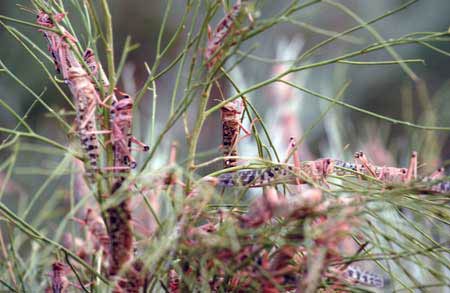Locust threat to croplands in Mali and Niger continues to grow, warns UN agency
The desert locust threat to Mali and Niger’s croplands continues to grow as swarms of the insects have arrived to the northern parts of both countries, the United Nations food agency warned today.

Desert locusts eating vegetation.
“Rains have already fallen in northern Niger and Mali. This will provide good breeding conditions and the possibility for a second generation in which large numbers of locusts could arise at the end of the summer,” said the Food and Agriculture Organization's (FAO) Senior Locust Forecasting Officer, Keith Cressman, in a news release.
“At that time, swarms could move to Mauritania, Algeria, Libya and even southern Morocco as well as threaten crops during the harvest period in the Sahel of West Africa,” he added.
According to FAO, the desert locust swarms can be dense and highly mobile – varying from less than one square kilometre to several hundred square kilometres, with at least 40 million and sometimes as many as 80 million locust adults in each square kilometre of swarm, and able to travel about five to 130 kilometres or more in a day.
A desert locust adult can consume roughly its own weight in fresh food per day, equivalent to about two grams every day. A very small part of an average swarm – or about one tonne of locusts – eats the same amount of food in one day as about 10 elephants or 25 camels or 2,500 people.
Locust infestations were first reported in southwest Libya near Ghat, and in southeast Algeria, earlier this year. In late March, FAO warned that swarms could arrive in Niger and Mali by June.
Survey and control operations were hampered by insecurity along both sides of the border in Algeria and Libya. Consequently, the groups and swarms that could not be controlled migrated across the Sahara to Mali and Niger.
“During the last three weeks, heavy rains fell in northern Mali and Niger, allowing the maturation of the Desert Locust adults that are now laying eggs in those areas. Hatching has started and will continue this month, causing locust numbers to increase further,” FAO noted.
In Niger, ground teams have treated 1,200 hectares against the pest since 5 June. However, control operations in northern Mali have not been carried out because of the ongoing political conflict in the region.
Chad, Sudan and other Sahelian countries may also be affected, and the UN has informed vulnerable Member States of the threat and prepared an action plan for the next two months, which entails, among other things, bringing stock to affected countries.
In addition, FAO has appealed for $10 million to maintain and expand operations. The funds would be used for expanding countries’ capacity to respond on a large scale and for logistical support such as vehicles, communication equipment and pesticide delivery.
Source: UN NEWS
- 338 reads
Human Rights
Ringing FOWPAL’s Peace Bell for the World:Nobel Peace Prize Laureates’ Visions and Actions

Protecting the World’s Cultural Diversity for a Sustainable Future

The Peace Bell Resonates at the 27th Eurasian Economic Summit

Declaration of World Day of the Power of Hope Endorsed by People in 158 Nations

Puppet Show I International Friendship Day 2020

